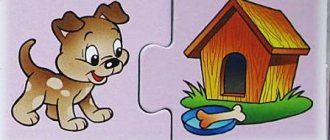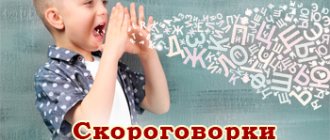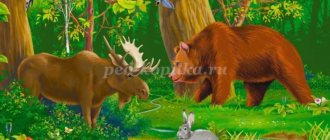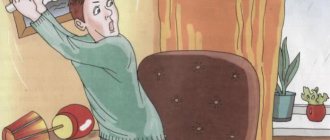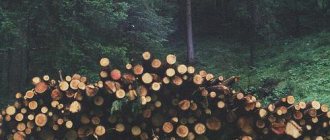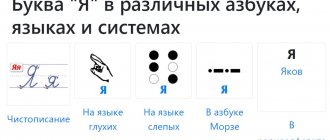Parents often wonder: how to teach a child to read and when should you start doing this? Experts recommend not to delay this issue. Of course, there is no point in showing your baby cards with letters, but he can and should read them.
To download a sheet with a story, right-click on it. In the window that opens, select “Save image as.” Save to your PC desktop and print.
How to read stories with pictures correctly
An adult and a child take part in the reading. The adult reads the lettered part of the story and pauses when an image appears in the text. The child names what he sees in the picture.
Having reached the end of the text, the adult asks the question: “What was the story about?”, “What were the names of ... (the characters).” Answering these questions, the little person does a lot of brain work. He uses his memory to try to remember the text. Carefulness and logic, looking at the pictures, recreates the order of actions in the story. In the future, this knowledge will be consolidated in the subconscious, and it will be easier for the child to write summaries at school. He will learn to isolate certain points and, based on them, reproduce the entire text in memory.
Texts with pictures instead of some words are different:
- black and white;
- colorful;
- with stickers.
Their use largely depends on the age and level of development of the baby. For example, to make the baby more interesting, you can offer him to color black and white pictures. This will allow the little man to better remember the fairy tale and then tell it in his own words.
By the way, you should not use such manuals in electronic form. Young children get tired quickly when working with static pictures on a computer monitor or tablet screen. This means that such exercises will be ineffective.
So, if it is not possible to purchase fairy tales and stories with pictures instead of certain words, then it is better to download and print them. During the lessons, these leaves can be collected into a book, and then together with the child, make a cover for which he will come up with and draw some kind of picture.
Benefits of classes
As the baby grows up, he should gradually be involved in the reading process. To do this, you can use aids such as fairy tales and stories with pictures instead of individual words. Such exercises will bring a lot of benefits to a child who does not yet know how to read:
- perception - the child learns to recognize what is shown in the picture;
- attention - concentrate on the subject and name it in time;
- speech - looking at the image, the baby can independently tell the story;
- memory - retelling a story from memory.
By the way, a similar technique is used by psychologists in kindergartens to test children’s knowledge and speech development.
Fairy tales with pictures instead of some words are also useful for children who are already learning to read. For example, if the baby already knows the letters, but it’s hard for him to combine them into words, then the picture will help him get a little distracted. As a result, he will not perceive reading as something tedious, and therefore will remain interested in learning. A similar effect will also help parents of those children who immediately dislike reading.
In addition, stories with pictures instead of individual words perfectly develop imagination and promote speech development. And this, in fact, is the main reason why children really need to read.
Books in which some words are replaced with drawings are also actively used in their practice by speech therapists. As a rule, the child does not try to pronounce words with sounds that are difficult for him to pronounce. But in the process of reading a funny fairy tale together, the baby becomes liberated, which greatly facilitates the specialist’s work in terms of producing a particular sound. A speech therapist hears how a child pronounces words with sounds that are difficult to pronounce in a normal, relaxed environment and makes a conclusion about whether there is an improvement after classes or not.
Learning to read. Pictures instead of words. Continuation
Children like to read funny texts where some words are replaced with pictures. At the learning stage, it is important to interest the child, to diversify the material not only in subject matter, but also in presentation. Today’s selection is suitable for children who are already familiar with the materials in the article “ Learning to Read.” Pictures instead of words." The continuation will be even more interesting. Here, not only reading skills are trained, but other speech and cognitive processes are also developed. For ease of selection, the texts are grouped into sections, whose names you can easily understand how the stories differ.
Training
Just keep reading stories with pictures. These texts are quite large in volume . They are a little difficult for beginners to master. However, you can get involved in the reading process at any stage and help your child.
Helper for adults
Quality. The previous article talked about texts that should be avoided. In addition, I will say that the pictures themselves are illegible. Either the image resolution on the computer is low, or an unsuccessful option was chosen to transfer the image to digital format (photography, scanner, webcam). Therefore, I recommend printing materials from the Internet onto an A5 sheet or 2 images per A4 sheet.
Unfamiliar pictures. If the child does not recognize the objects depicted or does not yet know what they are, you have a wonderful opportunity to educate the baby. Don't forget a previously unknown word (let's say it's violin). After reading, find relevant information in the children's encyclopedia (what is a violin, what does it consist of, who uses it and how). Select a few good photographs or paintings (orchestra, young musician). Find an audio recording, video, cartoon (“First Violin”) or presentation. The best option is to introduce a real object or living creature.
Sounds and letters
Onomatopoeia while reading is a playful moment, a short break. Ask your child to repeat the sounds that are in the story.
to better memorization of letters . This includes depicting a letter using your own body, laying it out from small objects, feeling and examining the elements of a plastic alphabet. Another option is to search for similar objects in the surrounding world for visual reinforcement. The following story is a great example of this.
Stickers
Many children's magazines publish stories where you need to paste pictures into the text. Why not make these stickers yourself? All you need is text with gaps and missing small images. The catch with these puzzles is that with all the arsenal of pictures, it’s not so easy to navigate through the text and choose the one you need. This is a difficult task, because there are no contour clues, only semantic ones in the text (adjectives, for example). The previous tasks can be completed by beginning readers. This will require the help of an adult or a reading level at which the child understands the meaning of what is being presented very well.
Here are the answers to the two previous pages, although the option chosen by your child can be very successful and funny.
Riddles and questions
The child read the story, but did he understand its content? Offer him stories with questions, let him try to answer. Like any other problem or riddle, this exercise trains thinking, which is especially important, precisely in conjunction with speech.
The task activates not only reasoning skills, but also attention to detail. Is it easy for you to answer us?
Which animal wore which mask? Why do you think so?
Fun and jokes
One of the indicators of normal child development is the ability to understand humor and respond to it. Of course, the categories of humor are very diverse, and jokes of a rather narrow range are useful for children. For example, these are various absurdities, absurdities, funny situations and puns. Offer your child the following stories with humor.
A child draws a fairy tale
The most creative version of playing with texts is when the child is given a template story , and he comes up with characters and details. You definitely won’t find identical stories. We can say that this is a page forgotten by the storyteller, or that the words from the fairy tale were stolen by a thief, and they need to be restored. Advantages of texts with disappeared pictures:
- An excellent imagination stimulator and a chance to draw. It doesn’t matter how well the child has drawing skills, the main thing is his desire to bring something of his own to the fairy tale. His imagination will tell him.
- Self-realization. All desires and dreams will instantly appear on the page from under the pencil of the young writer. Be attentive to these stories: they are like a door into the inner world of a child. Refrain from criticizing the plot and the options chosen by your child, so as not to discourage him from creating.
- Fairytale therapy. As an option for working out internal experiences or reflecting worldview, drawings work great. A fairy tale can always be discussed and continued, leading to a positive conclusion. The child is structured in such a way that the world of fantasy easily fits into reality and vice versa. Let's say there is a fear of the dark, you can defeat it in a fairy tale and transfer the experience to reality (buy a “magic lantern” that drives away fear).
- Multiple options. Use one text several times, and when the first plot is forgotten, return to writing again.
- Development of fine motor skills and hand writing skills. The drawings here are quite small, sometimes they need to be duplicated, so practicing with a pencil will be excellent. It is not necessary, but it is advisable for the child to place the image in a limited area (after all, he will continue to need to follow the margins in the notebook and the lines when writing).
- Entertainment. Organize an evening of homemade fairy tales in a children's group. While composing a text from start to finish is sometimes difficult for many guys, everyone can make a few inclusions to suit their taste. The results are unique, very funny texts.
- Activation of visual-motor memory. Small drawings are great for remembering and are a great tool for practicing. Short phrases with pictures as reference points create the backbone for the retelling.
- Increased self-confidence. How nice it is to tell a fairy tale that you wrote yourself. I didn’t read it in a book, I heard it in a recording, and so on. Encourage your child's desire to read his story to friends, family and acquaintances. Let him feel like both a writer and a reader.
From my own experience I will say: having become acquainted with a new way of presentation, I want to write and draw myself. A little children's trick: you don't know how to write a word yet, you can sketch it.
The first two fairy tales somewhat limit the child’s choice to familiar phrases; the subsequent ones are deliberately created with a large number of options. The fairy tale is suitable for girls, and the story about helping an ant is suitable for boys, but this is more of a recommendation. All texts are completed with questions and tasks for children, so that even after reading the game does not end.
Keep these fairy tales as sweet and pleasant memories dear to your heart.
Important!
At the end of the article you can download the file “Tales with spaces”. You will receive 4 stories in text format that are easy to print and start creating with your child.
If your child has difficulty drawing, then in one of the following articles you will find material for developing fine motor skills through drawing. A few simple visual techniques will allow you to draw animals, plants and much more. Then the baby will easily fill in the gaps in fairy tales.
At the end of the article, a short digression for adults. It’s done funny, as if we remembered it from children’s magazines or we are again trying to find a common language with loved ones and learning to read pictures instead of words. The continuation of the story is unknown. Have a good mood and enjoy reading with your child.
Download files
Skazki_s_probelami_pro_feyu
Skazka_s_probelami__Pro_muravya
skazki_s_probelami
skazki_s_probelami_2
PS Happy reading and creativity to you and your child!
Child psychologist
Anna Zubareva
For advertising purposes:
Do you want to know how to properly teach your child at home? Subscribe to site updates and you will always know when a new article has appeared:
Share on social media networks
RќСЂР°РІРёС‚СЃСЏ
Related posts:
- Learning to read. Pictures instead of words The new school year has begun. Some of the kids are mastering difficult school...
- Talking about birds and drawing step by step We continue to get acquainted with new simple drawing techniques for children. AND…
- Drawing step by step. Forest Today's material is selected for children of different ages. Thanks to the picture instructions you...
- Summer. Observations of nature. Trees and shrubs The fertile time is summer. Observations of nature (trees and shrubs,…
- Autumn calendar. November Let's flip through our autumn calendar. It's time to welcome November. The eleventh month of the year ends...

